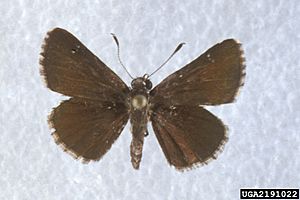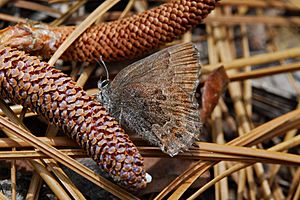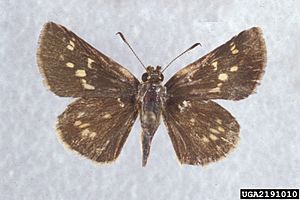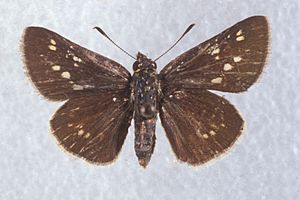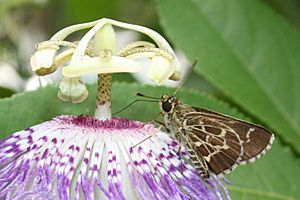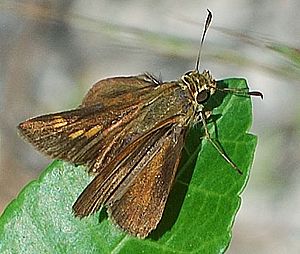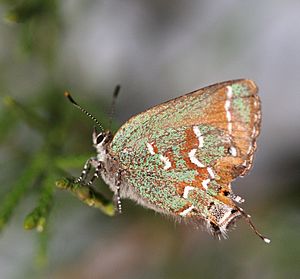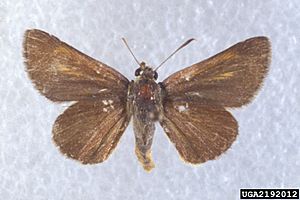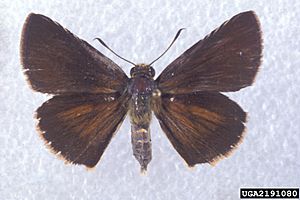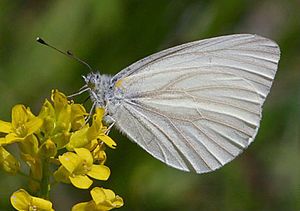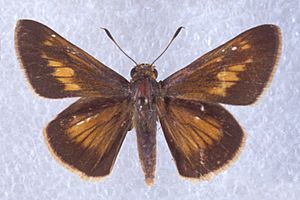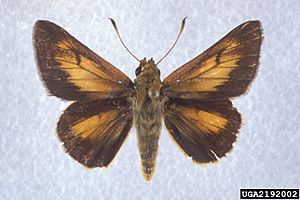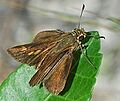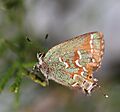List of butterflies of Georgia (U.S. state) facts for kids
This is a list of amazing butterflies that live in the U.S. state of Georgia. Georgia is home to many different kinds of butterflies, from tiny skippers to large, colorful swallowtails. These beautiful insects play an important role in nature, like helping plants grow by carrying pollen.
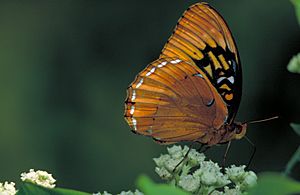
Contents
Understanding Butterfly Status
Butterflies, like many animals, have different levels of protection. Scientists use a system called NatureServe conservation status to show how rare or common a species is. This helps us know which butterflies need more help to survive.
What Do the Status Levels Mean?
- G2 - Imperiled: These butterflies are very rare and face a high risk of disappearing. They need special care and protection.
- G3 - Vulnerable: These butterflies are at risk of becoming imperiled. Their numbers might be going down, or they live in very specific places.
- G4 - Apparently Secure: These butterflies are generally safe, but there might be some concerns about their future.
- G5 - Secure: These butterflies are common and widespread. They are not currently at risk.
- T5 - Secure Subspecies: This means a specific type (subspecies) of a butterfly is common and not at risk.
Amazing Butterfly Families
Butterflies are grouped into families based on their shared features. Here are some of the main families you can find in Georgia.
Swallowtail Butterflies
Papilionidae are known for their large size and often have "tails" on their hindwings, like the tails of a swallow.
- Eastern tiger swallowtail (Papilio glaucus): This is one of the most common and easily recognized butterflies in Georgia. It's bright yellow with black stripes, looking a bit like a tiger! You can find it all over the state.
- Zebra swallowtail (Protographium marcellus): This butterfly has striking black and white stripes, just like a zebra. It's also found throughout Georgia.
- Black swallowtail (Papilio polyxenes): These butterflies are mostly black with rows of yellow or blue spots. They are common across Georgia.
- Pipevine swallowtail (Battus philenor): These beautiful butterflies are dark blue or black with iridescent blue-green on their hindwings. They are found statewide.
- Giant swallowtail (Papilio cresphontes): As its name suggests, this is the largest butterfly in North America. It has yellow markings on a dark brown background. You can find it all over Georgia.
Brush-Footed Butterflies
Nymphalidae are called "brush-footed" because their front legs are small and furry, almost like brushes. This is the largest butterfly family.
- Red admiral (Vanessa atalanta): This butterfly has black wings with bright orange-red bands. It's a common sight in many parts of Georgia.
- Monarch (Danaus plexippus): Famous for its long migrations, the Monarch is orange and black. While not a permanent resident, it visits Georgia during its amazing journeys.
- Common buckeye (Junonia coenia): This butterfly has large, colorful "eyespots" on its wings, which look like eyes and might scare away predators. It lives in the coastal plain and visits other areas.
- Viceroy (Limenitis archippus): This butterfly looks very similar to the Monarch, which helps it avoid predators because birds learn not to eat Monarchs. It lives all over Georgia.
- Diana fritillary (Speyeria diana): This beautiful butterfly is special because the males and females look very different. Males are orange and black, while females are dark blue and black. It lives in the mountains and upper Piedmont of Georgia.
Skipper Butterflies
Hesperiidae are often mistaken for moths because of their thick bodies and hooked antennae. They are very fast flyers, which is why they are called "skippers."
- Silver-spotted skipper (Epargyreus clarus): This is a common skipper with a distinctive silver-white patch on its hindwings. It's found all over Georgia.
- Long-tailed skipper (Urbanus proteus): This skipper has long "tails" on its hindwings and a metallic green body. It's common in southern Georgia and visits other parts of the state.
White and Sulphur Butterflies
Pieridae are usually white, yellow, or orange.
- Cabbage white (Pieris rapae): This is a very common white butterfly, often seen in gardens and fields. It's found all over Georgia.
- Orange sulphur (Colias eurytheme): This bright orange butterfly is common throughout Georgia.
- Cloudless sulphur (Phoebis sennae): A large, bright yellow butterfly that is common in southern Georgia and along the coast.
Gossamer-Winged Butterflies
Lycaenidae are usually small and delicate, with thin bodies. Many have shiny, iridescent wings.
- Eastern tailed-blue (Everes comyntas): This tiny blue butterfly has small, hair-like tails on its hindwings. It's found all over Georgia.
- Great purple hairstreak (Atlides halesus): This butterfly has beautiful iridescent blue and purple wings. It lives throughout Georgia.
Butterflies Needing Our Help
Some butterflies in Georgia are facing challenges and need our protection. Their habitats might be shrinking, or they might be sensitive to changes in the environment.
Imperiled Butterflies (G2 Status)
These butterflies are very rare and at high risk.
- Diana fritillary (Speyeria diana): As mentioned, this beautiful butterfly is found in the mountains and upper Piedmont. Its limited range makes it vulnerable.
- Dusky roadside skipper (Amblyscirtes alternata): This small skipper lives in the lower Piedmont and coastal plain.
- Frosted elfin (Callophrys irus): This tiny butterfly is found statewide but is still imperiled.
- Arogos skipper (Atrytone arogos): This skipper lives in a small area of eastern Georgia.
- West Virginia white (Pieris virginiensis): This white butterfly is found only in the mountains of Georgia.
- Early hairstreak (Erora laeta): This rare hairstreak is found only in the extreme northeast of Georgia.
- Berry's skipper (Euphyes berryi): This skipper is found in south, southeast, and coastal Georgia.
Vulnerable Butterflies (G3 Status)
These butterflies are at risk of becoming imperiled.
- Carolina roadside skipper (Amblyscirtes carolina): Found in the mountains, Piedmont, and upper coastal plain.
- Reversed roadside skipper (Amblyscirtes reversa): This skipper lives in the Piedmont near South Carolina.
- Lace-winged roadside-skipper (Amblyscirtes aesculapius): Found throughout Georgia.
- Palmetto skipper (Euphyes arpa): This skipper lives in extreme south Georgia along the Florida border.
- Juniper hairstreak (Callophrys gryneus): This hairstreak lives in most of Georgia, especially where Eastern redcedar trees grow.
- Dukes' skipper (Euphyes dukesi): Found along the coast of Georgia.
- Palatka skipper (Euphyes pilatka): Found along the coast and inland from the coast.
- Rare skipper (Problema bulenta): This skipper lives along the northern half of Georgia's coast.
- King's hairstreak (Satyrium kingi): Found in most of Georgia, except the far northwest and southeast.
- Mottled duskywing (Erynnis martialis): Found through most of Georgia, except the southeast.
- Dotted skipper (Hesperia attalus): This skipper lives only in the extreme southeastern tip of Georgia.
- Georgia satyr (Neonympha areolatus): Found statewide except in the mountains.
- Cofaqui giant-skipper (Megathymus cofaqui): Its range is limited to a north-south band through the middle of Georgia.
- Meske's skipper (Hesperia meskei): Found in colonies in eastern Georgia.
How You Can Help Butterflies
Even if a butterfly is "secure," it's important to protect all butterflies and their homes. Here are some ways you can help:
- Plant native flowers: Butterflies need nectar from flowers for food. Planting flowers that are native to Georgia helps them find food easily.
- Avoid pesticides: Chemicals used to kill insects can also harm butterflies. Try to use natural ways to control pests.
- Create butterfly gardens: Even a small garden with the right plants can be a great home for butterflies.
- Learn more: The more you know about butterflies, the better you can help protect them!
Images for kids
-
Dusky roadside skipper, G2 - imperiled
-
Frosted elfin, G2 - imperiled
-
Carolina roadside skipper, G3 - vulnerable
-
Reversed roadside skipper, G3 - vulnerable
-
Lace-winged roadside skipper, G3 - vulnerable
-
Palmetto skipper, G3 - vulnerable
-
Juniper hairstreak, G2 - imperiled
-
Arogos skipper, G2 - imperiled
-
Dukes' skipper, G3 - vulnerable
-
West Virginia white, G2 - imperiled
-
Palatka skipper, G3 - vulnerable
-
Rare skipper, G3 - vulnerable
See also


